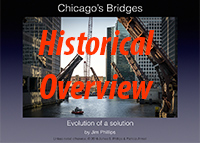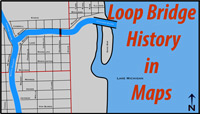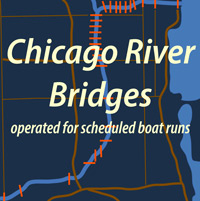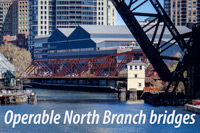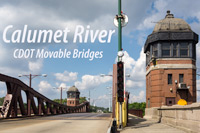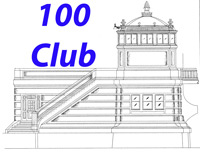W. Randolph Street bridge - opened December 21, 1984
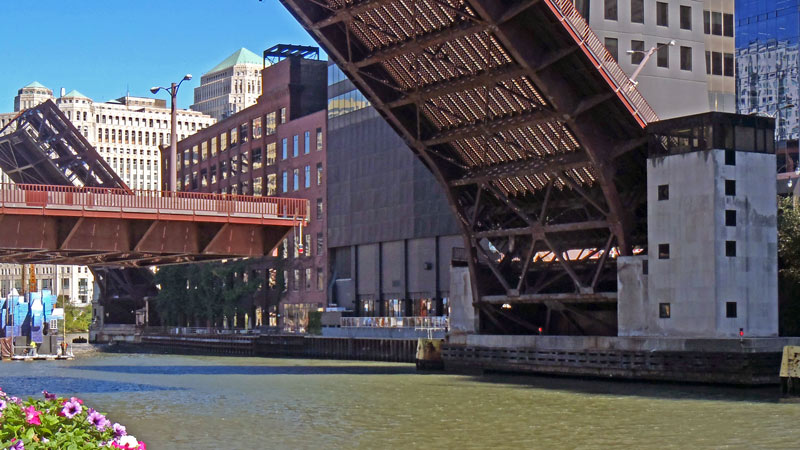
Randolph St. bridge raised for a 2014 boat run (The Great Chicago Fire structures visible in the background).
Sandwiched between two of the oldest downtown Chicago-type bascule bridges (Washington Blvd. – 101 yrs & Lake St. - 98 yrs), you will find the youngest. The Randolph St. bridge will mark 30 years of service on December 21, 2014.
Unlike most of the other downtown bridges, there was no commemoration of the opening. Buried on page 35 of the Chicago Tribune on Friday December 21, 1984, part of the announcement read: “The rebuilt Randolph Street bridge at Wacker Drive, will be opened without fanfare to evening rush-hour traffic Friday and is expected to be opened less often for river traffic.”
This modest beginning was a matter of timing. Mayor Harold Washington had been in office a short eight months and the “Council Wars” were underway. None of the city leaders were interested in a grand ceremony.
The bridge cost $18 million and took three years to complete. Bridge design was accomplished by the Chicago Public Works Department and Hazelet & Erdal Consulting Engineers. The construction contractor was Kenny Construction Company. It was a significant improvement over the 78 year old Scherzer rolling lift bridge it replaced. With an additional five feet of clearance over the river, the Tribune article estimated a tenfold reduction in required bridge lifts for river traffic.
Many observers see this bridge as less appealing from an architectural point of view than other downtown bridges. With its single basic bridgehouse and box-girder deck support, it reflects the nature of design aesthetics in the 1980's. It is one of the Loop's four modern (post 1950) single bridgehouse bridges and the second one completed in the 1980's.
The Chicago Loop bridges are influenced by and mirror the styles of the time period in which they were built. For me, the appearance of this bridge is better understood in the context of the early to mid-1980's automobiles (I'm a car guy). This was a time when boxy, utilitarian autos ruled the market (Ford Fairmonts, Chrysler K-cars, mini vans, Yugos, etc). I certainly see the similar influences in this bridge.

Crossing the Randolph St. bridge on a summer evening.
As with many of the bridge locations downtown, this Chicago-type bascule bridge is a snapshot in time. The Randolph St. river crossing has been home to movable bridges for about 175 years. These bridges have included floating bridges, center pier swing bridges, and the 1903 rolling lift bridge replaced by the current bridge.
As an historical aside, the Scherzer rolling lift bridge was the apparent movable "bridge of choice" toward the end of the 19th century. Chicago engineers were not pleased with the design for technical and pragmatic issues. (more detail)
These issues provided the incentive for Chicago engineers to find the solution that bears the name Chicago-type trunnion bascule bridge. Most of the bridges built downtown are of the Chicago-type.
However, in the early 20th century, Chicago was under a federal mandate to replace all the center pier swing bridges on the Chicago River and its branches. This was a job that the Public Works Department was unable to do alone.
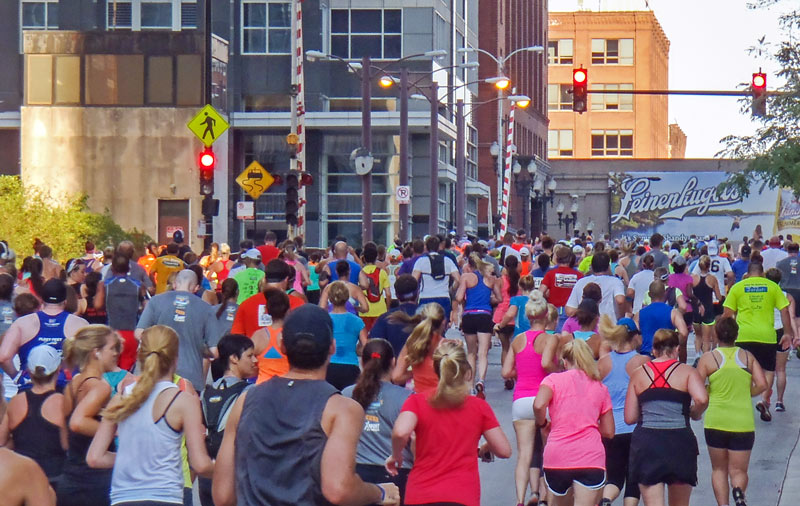
Runners in the 2013 Rock'n'Roll half marathon cross the Randolph St. bridge.
The Sanitary District of Chicago (now the Metropolitan Water Reclamation District) built a number bridges as well. Five of these were downtown (Van Buren St., Jackson Blvd., Randolph St., Dearborn St., & State St.). All but the bridge at Jackson Blvd. were rolling lift bridges.
The 1903 bridge at Randolph St. was built by the Scherzer Rolling Lift Bridge Company and was the last surviving rolling lift bridge downtown when it was removed in 1981. In an unusual coincidence of history, Hazelet & Erdal Consulting Engineers was the direct descendant of the Scherzer Rolling Lift Bridge Company.
Next time you cross the Randolph St. bridge, take a moment to appreciate its 30 years of service and visualize Chicago's rich bridge history. Then look south to the Washington Blvd. bridge to contrast the newest and oldest Loop bridges just a block apart.

